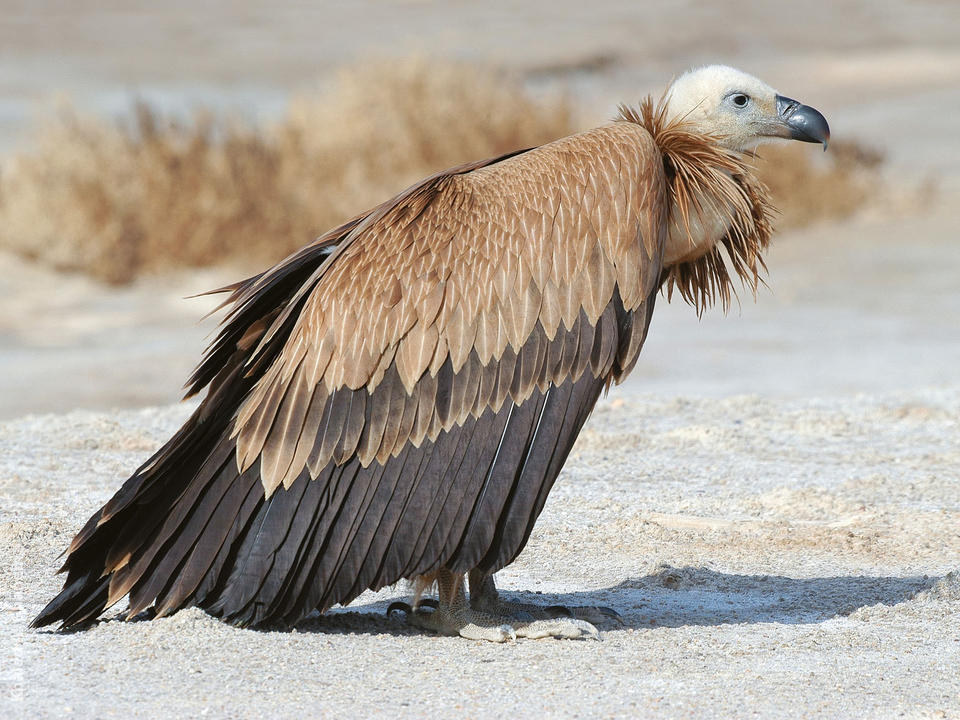Himalayan Griffon Bird Details
Gyps himalayensis
Himalayan Griffon,Himalayan Vulture;
Himalayan Giddh
Allan Octavian Hume, 1869
Accipitriformes (HAWKS, EAGLES and KITES)
Accipitridae
Gyps
India, Nepal, Bhutan, Tibet (China), and Pakistan.
Appearance :
It has a predominantly brown plumage with lighter undersides and a distinctive white ruff around its neck. Its head is relatively small and the beak is strong and hooked. The legs and feet are featherless.
Behaviour :
This vulture is known for its soaring flight, often seen gliding at great heights. It is a scavenger, primarily feeding on the carcasses of dead animals. Himalayan Griffons are generally solitary or found in small groups but may congregate in larger numbers at abundant food sources.
Habitat :
They inhabit mountainous regions, including high-altitude areas and steep, rugged terrains. They are commonly found in the Himalayas, including parts of Tibet, Nepal, and northern India.
Diet :
The diet of the Himalayan Griffon mainly consists of carrion, including the remains of large mammals such as deer, goats, and livestock. They play a crucial role in the ecosystem by cleaning up animal carcasses.
Conservation Status :
Least Concern
Distribution :
The species is distributed across the mountainous regions of the Himalayas, extending into northern India, Nepal, Bhutan, and parts of Tibet and Pakistan.
Population Size :
Estimates suggest 10,000 of individuals
Life Span :
The Himalayan Griffon can live up to 20 years in the wild.
Body And Tarsus:
- Body: The Himalayan Griffon has a robust and large body covered with dark brown feathers, lighter on the underside. It features a distinct white ruff around the neck, which is a notable characteristic of its plumage.
- Tarsus Length: Approximately 8.5 to 10 cm (3.3 to 3.9 inches).
Head And Bill :
- Head: The head is relatively small compared to the body, with a bald or featherless appearance. It has a pale color and is less conspicuous than the body feathers.
- Bill: The bill is strong, hooked, and designed for tearing flesh.
- Bill Length: Approximately 5 to 6 cm (2.0 to 2.4 inches).
Length :
About 85 to 105 cm (33 to 41 inches) from beak to tail.
Neck :
The neck is relatively short and covered by a distinctive white ruff of feathers.
Size :
Large bird, with a wingspan that is one of the most notable features.
Tail Details :
- Tail: The tail is broad and fan-shaped, helping with maneuverability in flight.
- Tail Length: Approximately 30 to 35 cm (12 to 14 inches).
Weight :
Typically ranges from 7 to 10 kg (15 to 22 lbs.
Wing :
The wings are long and broad with a pronounced dihedral shape, aiding in their soaring flight. The broad wings allow them to glide effortlessly for long distances.
Wing Span :
Ranges from 2.6 to 2.8 meters (8.5 to 9.2 feet).
Facial Feature :
The face of the Himalayan Griffon is relatively small with a pale, bald appearance. It is characterized by its small, hooked beak and a distinctive, bald head.
Nest Details :
- Nest: The nest is typically a large, bulky structure built on cliffs, in rocky outcrops, or on large trees. It is usually located in a secluded and elevated area to provide safety from predators.
- Nest Made Up Of: Nests are constructed from a variety of materials, including sticks, branches, grass, and sometimes even dung. The materials are gathered by the birds and built up into a large platform.
Breeding Season :
Breeding generally occurs between March and June
Nesting Season :
Primarily occurring in the spring and early summer.
Egg Color :
The eggs are usually pale, ranging from white to light brown, often with speckling or mottling.
Egg Length :
Approximately 8.0 to 9.0 cm (3.1 to 3.5 inches).
Egg Width and Weight :
- Egg Width: Approximately 6.0 to 7.0 cm (2.4 to 2.8 inches).
- Egg Weight: Around 150 to 200 grams (5.3 to 7.1 ounces).
Clutch Size :
Typically 1 to 2 eggs per clutch.
No. of Broods :
Raises only one brood per breeding season.
Incubation Period :
About 50 to 55 days.
Nestling Period :
Approximately 90 to 110 days after hatching.
Vocalization :
They may make hissing, grunting, or low-pitched calls, especially during interactions at the nest site.
Sex Demorphism :
Females being slightly larger and heavier than males.
Migration Details :
Himalayan Griffons are generally resident birds in their mountainous habitats, though some individuals may exhibit local or altitudinal movements. They do not undertake long migrations but may move to lower altitudes or different areas based on food availability and seasonal changes.






